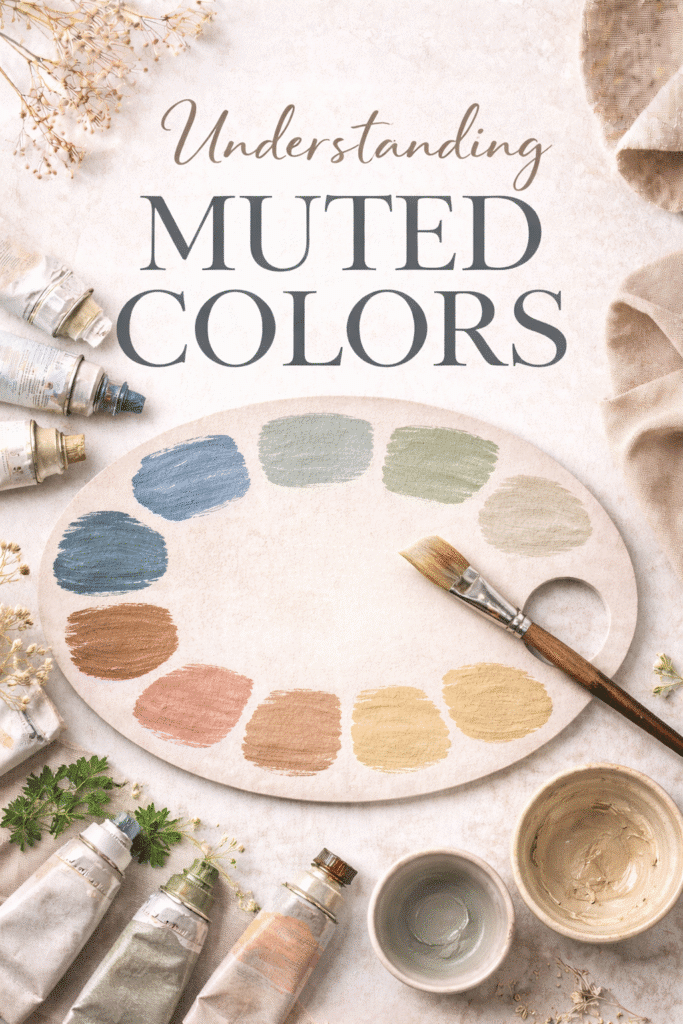Colors in abstract paintings are more than just visual elements—they carry meaning, emotion, and symbolism. By tapping into the subtle power of muted colors, we create an intuitive palette that evokes feelings and depth without overwhelming the senses.
When working with muted colors, we open up a world of subtlety, depth, and quiet emotion in our art. Understanding how to mix these shades gives us more control over the mood and tone of our paintings, allowing us to create pieces that resonate deeply.
In this blog, we’ll explore a curated collection of muted dark and soft colors, along with easy-to-follow recipes, to help you bring richness and contrast to your abstract paintings. Whether you’re drawn to soft neutrals, earthy tones, or dusty blues, these color mixes will guide you to create with intuition and confidence.
1. Soft Neutrals
- Taupe: Mix equal parts grey and brown, then add a small amount of white.
- Warm Beige: Combine yellow ochre with a touch of burnt sienna, then add white.
- Cool Grey: Mix black with white, and add a hint of blue.
- Warm Grey: Start with grey and add a small amount of burnt umber or burnt sienna.
- French Linen: Combine warm grey with a little yellow ochre.
- Mushroom: Mix light grey with a touch of burnt sienna and white.
- Stone: Blend grey with a little brown and white to soften.
- Soft Khaki: Mix yellow ochre and green, then tone down with white and a tiny bit of black.
- Putty: Mix warm grey with a touch of yellow ochre and a bit of white.
- Ecru: Combine yellow ochre, white, and a touch of burnt sienna.
- Ivory: Mix white with a touch of yellow ochre and a little burnt umber.
- Sand: Combine yellow ochre and burnt umber with white.
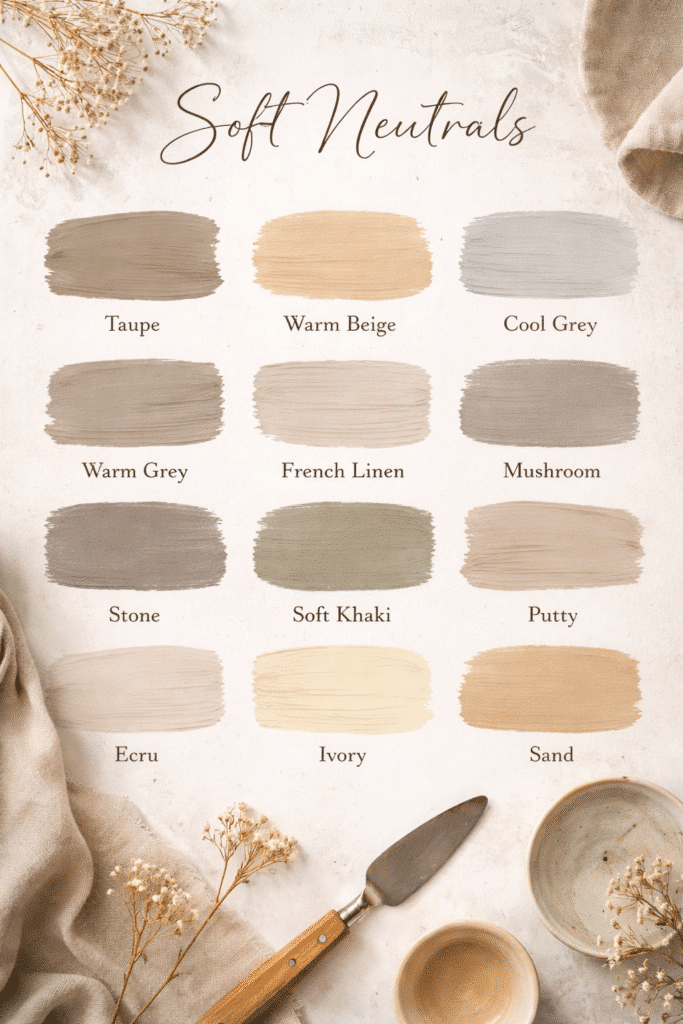
2. Dark Neutrals
- Payne’s Grey: Mix ultramarine blue with a touch of black and burnt umber.
- Graphite Grey: Blend black with a touch of white and a hint of blue or violet to soften.
- Mars Black: Pure black but with a slightly warmer tone when mixed with a little raw umber.
Warm Taupe: Combine burnt umber with a little grey and white.

3. Muted Greens
- Sage Green: Mix green with grey, and add a little white.
- Olive Green: Combine green, yellow ochre, and a touch of black or brown.
- Moss Green: Blend green, burnt sienna, and black with a little white.
- Pale Celadon: Mix green with white, then add a hint of blue and yellow.
- Pistachio: Combine green and yellow, then add white to soften it.
- Tea Green: Blend green with white and a touch of yellow.
- Dried Herb: Mix green with burnt umber and a touch of black.
- Dusty Jade: Blend green with blue and grey, then add white.
- Forest Green (Muted): Mix forest green with a bit of grey and black.
- Fern Green: Combine green with burnt umber and yellow ochre.
- Silver Green: Mix green with grey and a touch of white.
- Wasabi: Blend green with yellow and mute it with a little brown or grey.
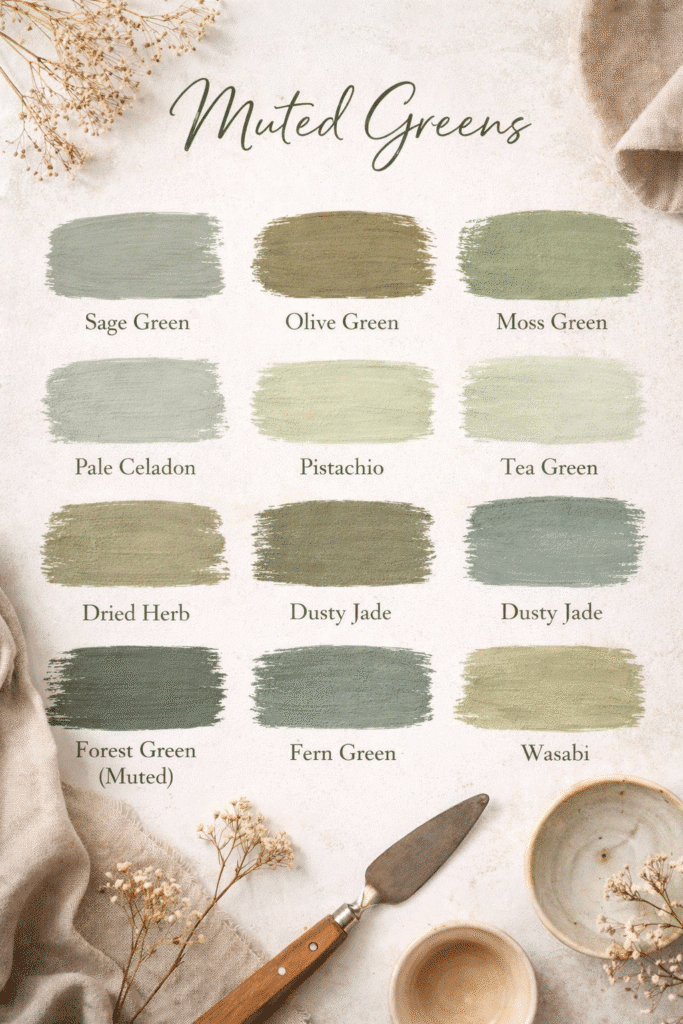
4. Muted Dark Greens
- Dark Olive Green: Mix yellow ochre with black, then add a little sap green or burnt umber.
- Deep Forest Green: Blend phthalo green or sap green with black and a touch of burnt umber.
- Hooker’s Green: Mix sap green with a small amount of burnt sienna or burnt umber to tone it down. Add a little yellow ochre for warmth, or grey for a cooler, muted effect.
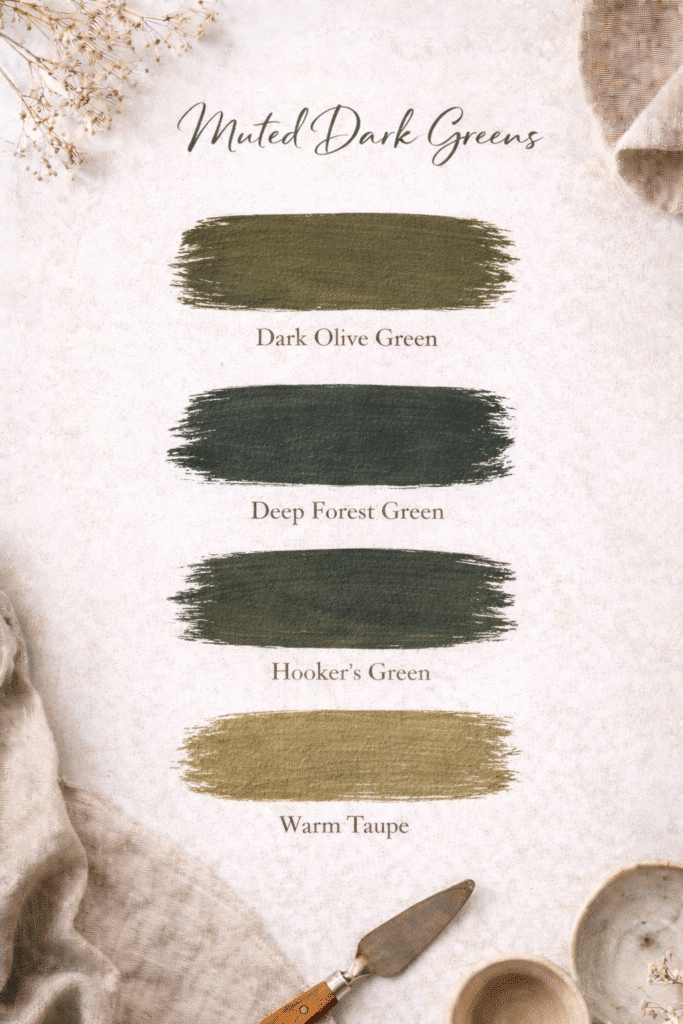
5. Dusty Blues and Pale Turquoises
- Dusty Slate Blue: Mix blue, black, and a touch of white.
- Duck Egg Blue: Combine blue, green, and white with a touch of grey.
- Powder Blue: Mix blue and white, then add a touch of grey.
- Stormy Blue: Blend blue and grey with a small amount of black.
- Pale Steel Blue: Mix blue, white, and a hint of black or grey.
- Faded Denim: Combine blue with grey and a small amount of black.
- Dusty Cerulean: Mix cerulean blue with grey and white.
- Light Seafoam: Combine turquoise and green with a little white.
- Ice Blue: Mix blue with white and a hint of grey.
- Muted Aquamarine: Combine blue, green, and white with a touch of grey.
- Sky Blue (Muted): Blend sky blue with white and grey to mute it.
- Pale Teal: Mix teal with white and a bit of grey.
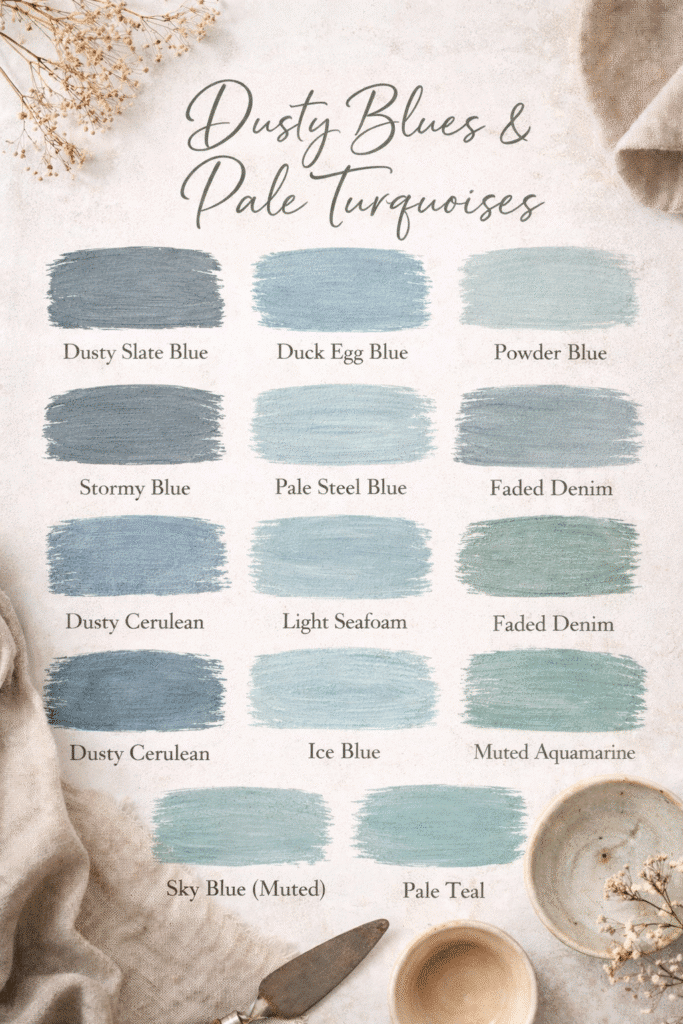
6. Dark Muted Blues
- Dusty Slate Blue: Mix blue, black, and a touch of white.
- Duck Egg Blue: Combine blue, green, and white with a touch of grey.
- Powder Blue: Mix blue and white, then add a touch of grey.
- Stormy Blue: Blend blue and grey with a small amount of black.
- Pale Steel Blue: Mix blue, white, and a hint of black or grey.
- Faded Denim: Combine blue with grey and a small amount of black.
- Dusty Cerulean: Mix cerulean blue with grey and white.
- Light Seafoam: Combine turquoise and green with a little white.
- Ice Blue: Mix blue with white and a hint of grey.
- Muted Aquamarine: Combine blue, green, and white with a touch of grey.
- Sky Blue (Muted): Blend sky blue with white and grey to mute it.
- Pale Teal: Mix teal with white and a bit of grey.

7. Muted Pink and Peach
- Blush Pink: Mix red with white, and tone down with a touch of brown or grey.
- Rose Quartz: Combine pink and white, then add a touch of burnt sienna or grey.
- Antique Rose: Mix red, burnt sienna, and white with a hint of grey.
- Pale Salmon: Blend orange, red, and white with a little brown to mute it.
- Coral Blush: Mix red with orange and add white, then tone down with brown or grey.
- Soft Peach: Combine orange, yellow, and white with a touch of pink.
- Dusty Rose: Mix red, white, and grey to mute the intensity.
- Desert Rose: Blend red, burnt sienna, and white with a touch of grey.
- Pastel Peach: Combine peach, white, and a touch of yellow.
- Warm Pink: Mix pink with a hint of orange or yellow to warm it up.
- Champagne Pink: Blend pink with white and a hint of yellow ochre.
- Old Mauve: Mix red, purple, and brown, then mute with grey.
- Muted Eggplant: Mix alizarin crimson with black and a touch of burnt umber.
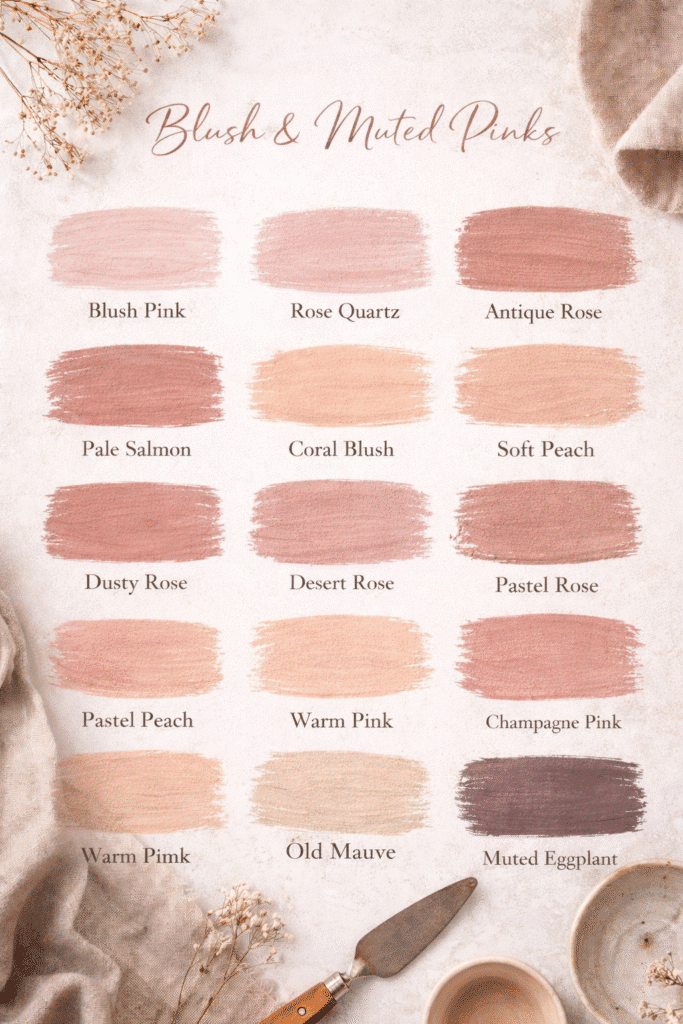
8. Burnt Sienna, Ochre, and Muted Earth Tones
- Burnt Sienna: Mix red, brown, and yellow.
- Raw Sienna: Combine yellow ochre with a touch of burnt umber.
- Yellow Ochre: Blend yellow and brown.
- Red Ochre: Mix red, yellow, and a touch of brown.
- Terracotta: Combine red, orange, and brown with a touch of grey.
- Sepia: Blend brown with a touch of red and black.
- Cocoa Brown: Mix brown and red with a small amount of black.
- Umber: Combine brown with a small amount of black and yellow.
- Clay: Blend brown with yellow ochre and a little red.
- Buff: Mix yellow ochre, white, and a touch of brown.
- Pale Caramel: Combine yellow, brown, and white.
- Fawn: Mix brown and yellow with a touch of white.
- Warm Brown (Muted): Combine brown with yellow and grey to mute.
- Burnt Umber: Combine raw umber with a touch of burnt sienna or yellow ochre for warmth.
- Raw Umber: Mix raw sienna with a small amount of black or burnt umber.
- Dark Chocolate: Combine burnt umber with a touch of black and a bit of burnt sienna.

9. Muted Yellows
- Pale Mustard: Mix yellow with a touch of brown and white.
- Wheat: Combine yellow ochre with white and a hint of brown.
- Honey Yellow: Mix yellow with a small amount of burnt sienna and white.
- Goldenrod: Blend yellow with a touch of orange and brown.
- Sand Dune: Mix yellow ochre with brown and white.
- Naples Yellow: Combine yellow, white, and a touch of burnt sienna.
- Soft Lemon: Mix yellow with white and a hint of grey.
- Buttermilk: Blend yellow with white and a tiny bit of brown.
- Dijon Yellow: Combine yellow and brown with a touch of black to mute.
- Cream Yellow: Mix yellow, white, and a touch of yellow ochre.
- Mimosa: Blend yellow with a hint of orange and white.
- Straw: Mix yellow ochre with white and a bit of brown.

10. Shades of White
- Cream White: Mix white with a touch of yellow ochre or beige.
- Eggshell: Blend white with a little yellow ochre and a tiny bit of grey.
- Off-White: Combine white with a touch of grey or beige.
- Vanilla: Mix white with yellow ochre and a hint of brown.
- Chalk White: Blend white with a tiny amount of grey.
- Antique White: Mix white with a touch of brown and yellow ochre.
- Alabaster: Combine white with a tiny bit of warm beige.
- Bone White: Blend white with a touch of yellow ochre and brown.
- Soft Pearl: Mix white with a hint of grey and yellow.
- Snow Drift White: Combine white with a touch of cool grey.
- Coconut Milk: Blend white with a hint of warm yellow.
- Flaxen White: Mix white with yellow ochre and a little beige.

Conclusion


